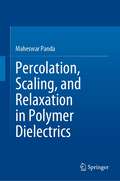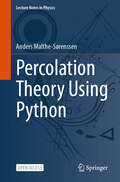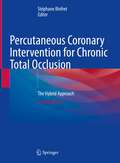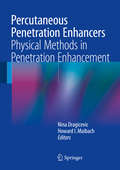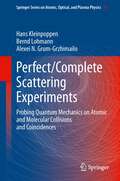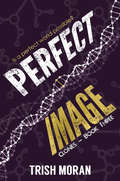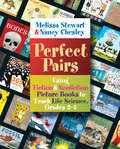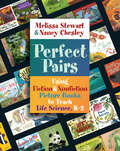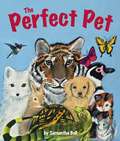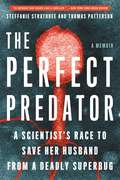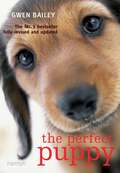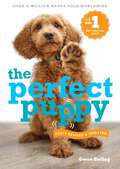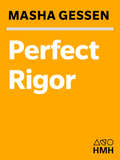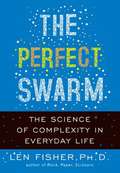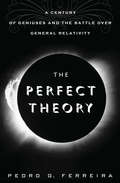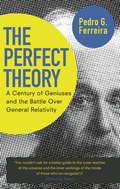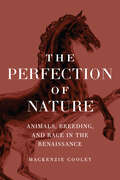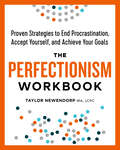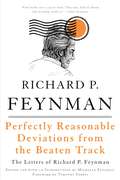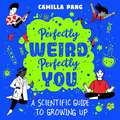- Table View
- List View
Percolation, Scaling, and Relaxation in Polymer Dielectrics
by Maheswar PandaThis book provides a foundational understanding of polymer dielectrics based on percolative composites. It covers the microstructure and physical properties, such as dielectric, electrical, magnetic, and rheological properties, of polymer composites, as well as how these properties can be explained using various theoretical models and spectroscopy techniques, such as dielectric spectroscopy, impedance spectroscopy, and conductivity spectroscopy. The book also discusses non-percolative polymer composites and the suitability of polymer dielectrics for electrical energy storage in various devices. It is intended for graduate students and professionals in fields such as condensed matter physics, applied physics, statistical physics, materials science, polymer science and technology, chemistry, and engineering. It will be particularly useful for physicists, materials scientists, polymer scientists, chemists, engineers, and others interested in the physics and applications of percolative composites based on polymer matrix.
Percolation Theory Using Python (Lecture Notes in Physics #1029)
by Anders Malthe-SørenssenThis course-based open access textbook delves into percolation theory, examining the physical properties of random media—materials characterized by varying sizes of holes and pores. The focus is on both the mathematical foundations and the computational and statistical methods used in this field. Designed as a practical introduction, the book places particular emphasis on providing a comprehensive set of computational tools necessary for studying percolation theory. Readers will learn how to generate, analyze, and comprehend data and models, with detailed theoretical discussions complemented by accessible computer codes. The book's structure ensures a complete exploration of worked examples, encompassing theory, modeling, implementation, analysis, and the resulting connections between theory and analysis. Beginning with a simplified model system—a model porous medium—whose mathematical theory is well-established, the book subsequently applies the same framework to realistic random systems. Key topics covered include one- and infinite-dimensional percolation, clusters, scaling theory, diffusion in disordered media, and dynamic processes. Aimed at graduate students and researchers, this textbook serves as a foundational resource for understanding essential concepts in modern statistical physics, such as disorder, scaling, and fractal geometry.
Percutaneous Coronary Intervention for Chronic Total Occlusion: The Hybrid Approach
by Stéphane RinfretThe second edition of this essential text provides readers with a detailed guide to performing various percutaneous coronary intervention (PCI) techniques for treating coronary chronic total occlusion (CTO). PCI continues to be an effective procedure to help patients with this pathology, with high success and low complications rates. Chapters feature a step-by-step approach to relevant techniques and describe their potential pitfalls, enabling the reader to develop a thorough understanding of how to perform those procedures successfully. Details of the latest methods for angiography analysis and the management of ostial CTOs, plus heavily revised chapters on topics such as contemporary device-based antegrade dissection and the retrograde approach through septal and non-septal collateral channels ensure that this Work remains the most up-to-date reference on the subject. Percutaneous Intervention for Coronary Chronic Total Occlusion: The Hybrid Approach represents a vital reference to assist practicing and trainee interventional cardiologist in learning these techniques. Various examples are provided, with a vast selection of still images and angiographic video loops to enable the reader become confident in applying these methodologies into their day-to day clinical practice.
Percutaneous Penetration Enhancers Physical Methods in Penetration Enhancement
by Howard I. Maibach Nina DragicevicPercutaneous Penetration Enhancers in a mini-series format comprising five volumes, represents the most comprehensive reference on enhancement methods - both well established and recently introduced - in the field of dermal/transdermal drug delivery. In detail the broad range of both chemical and physical methods used to enhance the skin delivery of drugs is described. All aspects of drug delivery and measurement of penetration are covered, and the latest findings are provided on skin structure and function, mathematics in skin permeation, and modern analytical techniques adapted to assess and measure penetration. In offering a detailed description of the methods currently in use for penetration enhancement, this book will be of value for researchers, pharmaceutical scientists, practitioners, and also students.
The Peregrine Returns: The Art and Architecture of an Urban Raptor Recovery
by Mary Hennen Peggy Macnamara Stephanie WarePeregrine falcons have their share of claims to fame. With a diving speed of over two hundred miles per hour, these birds of prey are the fastest animals on earth or in the sky, and they are now well known for adapting from life on rocky cliffs to a different kind of mountain: modern skyscrapers. But adaptability only helps so much. In 1951, there were no peregrines left in Illinois, for instance, and it looked as if the species would be wiped out entirely in North America. Today, however, peregrines are flourishing. In The Peregrine Returns, Mary Hennen gives wings to this extraordinary conservation success story. Drawing on the beautiful watercolors of Field Museum artist-in-residence Peggy Macnamara and photos by Field Museum research assistant Stephanie Ware, as well as her own decades of work with peregrines, Hennen uses a program in Chicago as a case study for the peregrines’ journey from their devastating decline to the discovery of its cause (a thinning of eggshells caused by a by-product of DDT), through to recovery, revealing how the urban landscape has played an essential role in enabling falcons to return to the wild—and how people are now learning to live in close proximity to these captivating raptors. Both a model for conservation programs across the country and an eye-opening look at the many creatures with which we share our homes, this richly illustrated story is an inspiring example of how urban architecture can serve not only our cities’ human inhabitants, but also their wild ones.
Perfect/Complete Scattering Experiments
by Hans Kleinpoppen Bernd Lohmann Alexei N. Grum-GrzhimailoThe main goal of this book is to elucidate what kind of experiment must be performed in order to determine the full set of independent parameters which can be extracted and calculated from theory, where electrons, photons, atoms, ions, molecules, or molecular ions may serve as the interacting constituents of matter. The feasibility of such perfect' and-or `complete' experiments, providing the complete quantum mechanical knowledge of the process, is associated with the enormous potential of modern research techniques, both, in experiment and theory. It is even difficult to overestimate the role of theory in setting of the complete experiment, starting with the fact that an experiment can be complete only within a certain theoretical framework, and ending with the direct prescription of what, and in what conditions should be measured to make the experiment `complete'. The language of the related theory is the language of quantum mechanical amplitudes and their relative phases. This book captures the spirit of research in the direction of the complete experiment in atomic and molecular physics, considering some of the basic quantum processes: scattering, Auger decay and photo-ionization. It includes a description of the experimental methods used to realize, step by step, the complete experiment up to the level of the amplitudes and phases. The corresponding arsenal includes, beyond determining the total cross section, the observation of angle and spin resolved quantities, photon polarization and correlation parameters, measurements applying coincidence techniques, preparing initially polarized targets, and even more sophisticated methods. The `complete' experiment is, until today, hardly to perform. Therefore, much attention is paid to the results of state-of-the-art experiments providing detailed information on the process, and their comparison to the related theoretical approaches, just to mention relativistic multi-configurational Dirac-Fock, convergent close-coupling, Breit-Pauli R-matrix, or relativistic distorted wave approaches, as well as Green's operator methods. This book has been written in honor of Herbert Walther and his major contribution to the field but even to stimulate advanced Bachelor and Master students by demonstrating that obviously nowadays atomic and molecular scattering physics yields and gives a much exciting appreciation for further advancing the field.
Perfect Image: The Clone Series (The Clone Series #3)
by Trish MoranThe final installment of Trish Moran's acclaimed young adult series exploring humanity, technology, and the problems of growing up in a dystopian future. Perfect for fans of The Giver and the Divergent trilogy.The Compound Labs, the original group of clones freed from the notorious medical centre, are continuing to live successfully alongside the normal humans in society.They are uneasy to realize that the militant group of clones, the Radicals, are gaining more and more followers from the Labs and their Hybrid children.The Radicals, sponsored by an anonymous billionaire, have a vision of a future society where every member is given a designated role according to their abilities. They have plans to rule this new way of life with a specially created perfect clone and his equally talented team, showing little regard for those they consider inferior mentally and physically.Have they created a team of unfeeling, super-intelligent people who will stop at nothing to achieve their aims?Are the Compound Labs strong enough to defeat them in their crusade? Can a young Hybrid girl use the power of love and compassion to challenge the course they have set themselves?
Perfect Image: The Clone Series (The\clone Ser. #3)
by Trish MoranThe final installment of Trish Moran's acclaimed young adult series exploring humanity, technology, and the problems of growing up in a dystopian future. Perfect for fans of The Giver and the Divergent trilogy.The Compound Labs, the original group of clones freed from the notorious medical centre, are continuing to live successfully alongside the normal humans in society.They are uneasy to realize that the militant group of clones, the Radicals, are gaining more and more followers from the Labs and their Hybrid children.The Radicals, sponsored by an anonymous billionaire, have a vision of a future society where every member is given a designated role according to their abilities. They have plans to rule this new way of life with a specially created perfect clone and his equally talented team, showing little regard for those they consider inferior mentally and physically.Have they created a team of unfeeling, super-intelligent people who will stop at nothing to achieve their aims?Are the Compound Labs strong enough to defeat them in their crusade? Can a young Hybrid girl use the power of love and compassion to challenge the course they have set themselves?
Perfect Pairs, 3-5: Using Fiction & Nonfiction Picture Books to Teach Life Science, Grades 3-5
by Melissa Stewart Nancy ChesleyHands-on lessons can be fun and compelling, but when it comes to life science, they aren't always possible, practical, effective, or safe. Children can't follow wolves as they hunt elk, visit a prehistoric swamp, or shrink down to the size of a molecule and observe photosynthesis firsthand. But they can explore a whole world of animals, plants, and ecosystems through the pages of beautifully illustrated, science-themed picture books. Perfect Pairs , which marries fiction and nonfiction picture books focused on life science, helps educators think about and teach life science in a whole new way. Each of the twenty lessons in this book is built around a pair of books that introduces a critical life science concept and guides students through an inquiry-based investigative process to explore that idea-;from life cycles and animal-environment interactions to the inheritance of traits and the critical role of energy in our world. Each lesson starts with a Wonder Statement and comprises three stages. Engaging Students features a hands-on activity that captures student interest, uncovers current thinking, and generates vocabulary. The heart of the investigative process, Exploring with Students, spotlights the paired books as the teacher reads aloud and helps students find and organize information into data tables. Encouraging Students to Draw Conclusions shows students how to review and analyze the information they have collected. Bringing high-quality science-themed picture books into the classroom engages a broad range of students, addresses the Performance Expectations outlined in the Next Generation Science Standards, and supports the goals of the Common Core State Standards for English Language Arts. Even if you are science shy, Perfect Pairs can help you become a more confident teacher whose classroom buzzes with curious students eager to explore their natural world.
Perfect Pairs, K-2: Using Fiction & Nonfiction Picture Books to Teach Life Science, K-2
by Melissa Stewart Nancy ChesleyHands-on lessons can be fun and compelling, but when it comes to life science, they aren't always possible, practical, effective, or safe. Children can't follow a lion as it stalks a gazelle, visit the exotic kapok tree in a rain forest, or swim alongside the underwater life in a pond. But they can explore a whole world of animals, plants, and ecosystems through the pages of beautifully illustrated, science-themed picture books. Perfect Pairs , which marries fiction and nonfiction picture books focused on life science, helps educators think about and teach life science in a whole new way. Each of the twenty-two lessons in this book is built around a pair of books that introduces a critical life science concept and guides students through an inquiry-based investigative process to explore that idea-;from animal/environment interactions to the role of structure in plant and animal survival, from inheritance of traits to variation of species. Each lesson starts with a Wonder Statement- and comprises three stages. Engaging Students- features a hands-on activity that captures student interest, uncovers current thinking, and generates vocabulary. The heart of the investigative process, Exploring with Students,- spotlights the paired books as the teacher reads aloud and helps students find and organize information into data tables. Encouraging Students to Draw Conclusions- shows students how to review and analyze the information they have collected. Bringing high-quality science-themed picture books into the classroom engages a broad range of students, addresses the Performance Expectations outlined in the Next Generation Science Standards, and supports the goals of the Common Core State Standards for English Language Arts. Even if you are science shy,Perfect Pairs can help you become a more confident teacher whose classroom buzzes with curious students eager to explore their natural world.
The Perfect Pet
by Samantha BellStarting with the Kingdom Animalia, a child walks through the various animal classes trying to choose the perfect pet.
The Perfect Predator: A Scientist's Race to Save Her Husband from a Deadly Superbug: A Memoir
by Teresa Barker Steffanie Strathdee Thomas PattersonA riveting memoir of one woman's extraordinary effort to save her husband's life-and the discovery of a forgotten cure that has the potential to save millions more.Epidemiologist Steffanie Strathdee and her husband, psychologist Tom Patterson, were vacationing in Egypt when Tom came down with a stomach bug. What at first seemed like a case of food poisoning quickly turned critical, and by the time Tom had been transferred via emergency medevac to the world-class medical center at UC San Diego, where both he and Steffanie worked, blood work revealed why modern medicine was failing: Tom was fighting one of the most dangerous, antibiotic- resistant bacteria in the world.Frantic, Steffanie combed through research old and new and came across phage therapy: the idea that the right virus, aka "the perfect predator," can kill even the most lethal bacteria. Phage treatment had fallen out of favor almost 100 years ago, after antibiotic use went mainstream. Now, with time running out, Steffanie appealed to phage researchers all over the world for help. She found allies at the FDA, researchers from Texas A&M, and a clandestine Navy biomedical center-and together they resurrected a forgotten cure.A nail-biting medical mystery, The Perfect Predator is a story of love and survival against all odds, and the (re)discovery of a powerful new weapon in the global superbug crisis.
Perfect Puppy: The No.1 bestseller fully revised and updated
by Gwen BaileyNEW EDITION OUT AUGUST 2024 Gwen Bailey's puppy care guide has helped hundreds of thousands of owners throughout the world raise a problem-free dog. Now, updated with the latest findings in canine behaviour and a completely new user-friendly design, this revised edition will teach you how to raise a problem-free dog. From housetraining to playing games, it will show you how to teach your dog good manners and build his confidence with the world around him. There are step-by-step training and socialisation plans as well as a guide to understanding and preventing biting, chewing and other problems.If you want your puppy to develop into a happy, well-behaved and friendly adult dog, you cannot afford to be without this book.
Perfect Puppy: The No.1 bestseller fully revised and updated
by Gwen BaileyNEW EDITION OUT AUGUST 2024 Gwen Bailey's puppy care guide has helped hundreds of thousands of owners throughout the world raise a problem-free dog. Now, updated with the latest findings in canine behaviour and a completely new user-friendly design, this revised edition will teach you how to raise a problem-free dog. From housetraining to playing games, it will show you how to teach your dog good manners and build his confidence with the world around him. There are step-by-step training and socialisation plans as well as a guide to understanding and preventing biting, chewing and other problems.If you want your puppy to develop into a happy, well-behaved and friendly adult dog, you cannot afford to be without this book.
Perfect Puppy: The classic puppy training book now fully revised and updated
by Gwen BaileyTHE NO.1 BEST-SELLING GUIDE - OVER 1/2 MILLION BOOKS SOLD WORLDWIDEGwen Bailey's ORIGINAL puppy training guide is back - FULLY REVISED and UPDATED for 2024!Packed with the most up-to-date findings in canine behaviour and sporting a brand-new, user-friendly design, this stunning edition will teach how to raise a problem-free dog. From housetraining to games and shared activities, learn how to teach your dog good manners and build their confidence in the world around them. Complete with step-by-step training and socialisation plans, as well as no-nonsense guides to understanding and preventing biting, chewing, aggression, and other problems.* BRAND NEW content and UPDATES throughout.* FRESH photography, that brings every lesson to life.* The LATEST methods and practices, to stay ahead in the ever-evolving world of dog training.* SUPER CLEAR, and USER-FRIENDLY layout.* Over half a million copies sold worldwide!Join hundreds of thousands of owners across the world who have already transformed their puppies into healthy, happy and obedient companions.
Perfect Puppy: The classic puppy training book now fully revised and updated
by Gwen BaileyTHE NO.1 BEST-SELLING GUIDE - OVER 1/2 MILLION BOOKS SOLD WORLDWIDEGwen Bailey's ORIGINAL puppy training guide is back - FULLY REVISED and UPDATED for 2024!Packed with the most up-to-date findings in canine behaviour and sporting a brand-new, user-friendly design, this stunning edition will teach how to raise a problem-free dog. From housetraining to games and shared activities, learn how to teach your dog good manners and build their confidence in the world around them. Complete with step-by-step training and socialisation plans, as well as no-nonsense guides to understanding and preventing biting, chewing, aggression, and other problems.* BRAND NEW content and UPDATES throughout.* FRESH photography, that brings every lesson to life.* The LATEST methods and practices, to stay ahead in the ever-evolving world of dog training.* SUPER CLEAR, and USER-FRIENDLY layout.* Over half a million copies sold worldwide!Join hundreds of thousands of owners across the world who have already transformed their puppies into healthy, happy and obedient companions.
Perfect Rigor: A Genius and the Mathematical Breakthrough of the Century
by Masha GessenA gripping and tragic tale that sheds rare light on the unique burden of genius In 2006, an eccentric Russian mathematician named Grigori Perelman solved the Poincare Conjecture, an extremely complex topological problem that had eluded the best minds for over a century. A prize of one million dollars was offered to anyone who could unravel it, but Perelman declined the winnings, and in doing so inspired journalist Masha Gessen to tell his story. Drawing on interviews with Perelman's teachers, classmates, coaches, teammates, and colleagues in Russia and the United States--and informed by her own background as a math whiz raised in Russia--Gessen uncovered a mind of unrivaled computational power, one that enabled Perelman to pursue mathematical concepts to their logical (sometimes distant) end. But she also discovered that this very strength turned out to be Perelman's undoing and the reason for his withdrawal, first from the world of mathematics and then, increasingly, from the world in general.
The Perfect Swarm: The Science of Complexity in Everyday Life
by Len FisherOne of the greatest discoveries of recent times is that the complex patterns we find in life are often produced when all of the individuals in a group follow the same simple rule. This process of "self-organization” reveals itself in the inanimate worlds of crystals and seashells, but as Len Fisher shows, it is also evident in living organisms, from fish to ants to human beings. The coordinated movements of fish in shoals, for example, arise from the simple rule: "Follow the fish in front. ” Traffic flow arises from simple rules: "Keep your distance” and "Keep to the right. ” Now, in his new book, Fisher shows how we can manage our complex social lives in an ever more chaotic world. His investigation encompasses topics ranging from "swarm intelligence” to the science of parties and the best ways to start a fad. Finally, Fisher sheds light on the beauty and utility of complexity theory. An entertaining journey into the science of everyday life, The Perfect Swarm will delight anyone who wants to understand the complex situations in which we so often find ourselves.
The Perfect Theory: A Century of Geniuses and the Battle over General Relativity
by Pedro G. Ferreira&“One of the best popular accounts of how Einstein and his followers have been trying to explain the universe for decades&” (Kirkus Reviews, starred review). Physicists have been exploring, debating, and questioning the general theory of relativity ever since Albert Einstein first presented it in 1915. This has driven their work to unveil the universe&’s surprising secrets even further, and many believe more wonders remain hidden within the theory&’s tangle of equations, waiting to be exposed. In this sweeping narrative of science and culture, an astrophysicist brings general relativity to life through the story of the brilliant physicists, mathematicians, and astronomers who have taken up its challenge. For these scientists, the theory has been both a treasure trove and an enigma. Einstein&’s theory, which explains the relationships among gravity, space, and time, is possibly the most perfect intellectual achievement of modern physics—yet studying it has always been a controversial endeavor. Relativists were the target of persecution in Hitler&’s Germany, hounded in Stalin&’s Russia, and disdained in 1950s America. Even today, PhD students are warned that specializing in general relativity will make them unemployable. Still, general relativity has flourished, delivering key insights into our understanding of the origin of time and the evolution of all the stars and galaxies in the cosmos. Its adherents have revealed what lies at the farthest reaches of the universe, shed light on the smallest scales of existence, and explained how the fabric of reality emerges. Dark matter, dark energy, black holes, and string theory are all progeny of Einstein&’s theory. In the midst of a momentous transformation in modern physics, as scientists look farther and more clearly into space than ever before, The Perfect Theory exposes the greater relevance of general relativity, showing us where it started, where it has led—and where it can still take us.
The Perfect Theory: A Century of Geniuses and the Battle over General Relativity
by Professor Pedro G. FerreiraAlbert Einstein's General Theory of Relativity is possibly the most perfect intellectual achievement in modern physics. Anything that involves gravity, the force that powers everything on the largest, hottest or densest of scales, can be explained by it. From the moment Einstein first proposed the theory in 1915, it was received with enthusiasm yet also with tremendous resistance, and for the following ninety years was the source of a series of feuds, vendettas, ideological battles and persecutions featuring a colourful cast of characters. A gripping, vividly told story, A Perfect Theory entangles itself with the flashpoints of modern history and is the first complete popular history of the theory, showing how it has informed our understanding of exactly what the universe is made of and how much is still undiscovered: from the work of the giant telescopes in the deserts of Chile to our newest ideas about black holes and the Large Hadron Collider deep under French and Swiss soil.
The Perfect Wave
by Heinrich PasAlmost weightless and able to pass through the densest materials with ease, neutrinos seem to defy the laws of nature. But these mysterious particles may hold the key to our deepest questions about the universe, says physicist Heinrich Pas. In "The Perfect Wave," Pas serves as our fluent, deeply knowledgeable guide to a particle world that tests the boundaries of space, time, and human knowledge. The existence of the neutrino was first proposed in 1930, but decades passed before one was detected. Pas animates the philosophical and scientific developments that led to and have followed from this seminal discovery, ranging from familiar topics of relativity and quantum mechanics to more speculative theories about dark energy and supersymmetry. Many cutting-edge topics in neutrino research--conjectures about the origin of matter, extra-dimensional spacetime, and the possibility of time travel--remain unproven. But Pas describes the ambitious projects under way that may confirm them, including accelerator experiments at CERN and Fermilab, huge subterranean telescopes designed to detect high-energy neutrino radiation, and the Planck space observatory scheduled to investigate the role of neutrinos in cosmic evolution. As Pass history of the neutrino illustrates, what is now established fact often sounded wildly implausible and unnatural when first proposed. The radical side of physics is both an exciting and an essential part of scientific progress, and "The Perfect Wave" renders it accessible to the interested reader.
The Perfection of Nature: Animals, Breeding, and Race in the Renaissance
by Mackenzie CooleyA deep history of how Renaissance Italy and the Spanish empire were shaped by a lingering fascination with breeding. The Renaissance is celebrated for the belief that individuals could fashion themselves to greatness, but there is a dark undercurrent to this fêted era of history. The same men and women who offered profound advancements in European understanding of the human condition—and laid the foundations of the Scientific Revolution—were also obsessed with controlling that condition and the wider natural world. Tracing early modern artisanal practice, Mackenzie Cooley shows how the idea of race and theories of inheritance developed through animal breeding in the shadow of the Spanish Empire. While one strand of the Renaissance celebrated a liberal view of human potential, another limited it by biology, reducing man to beast and prince to stud. “Race,” Cooley explains, first referred to animal stock honed through breeding. To those who invented the concept, race was not inflexible, but the fragile result of reproductive work. As the Spanish empire expanded, the concept of race moved from nonhuman to human animals. Cooley reveals how, as the dangerous idea of controlled reproduction was brought to life again and again, a rich, complex, and ever-shifting language of race and breeding was born. Adding nuance and historical context to discussions of race and human and animal relations, The Perfection of Nature provides a close reading of undertheorized notions of generation and its discontents in the more-than-human world.
The Perfectionism Workbook: Proven Strategies to End Procrastination, Accept Yourself, and Achieve Your Goals
by Taylor Newendorp MA, LCPCThe Perfectionism Workbook offers actionable exercises to help you overcome the barriers created by perfectionism and develop skills for living a healthier, more gratifying life.The desire to continuously improve can be a positive trait that fuels success. However, those same aspirations can also turn into perfectionism, which causes us to put unrealistic pressure on ourselves and set impossible standards that negatively influence how we think and act.In his work as a clinical therapist, Taylor Newendorp has successfully used cognitive behavioral therapy (CBT) to help countless patients who live with the immense pressure of perfectionism and other related issues such as OCD, anxiety disorders, eating disorders, or depression. In The Perfectionism Workbook, Taylor delivers practical, effective exercises to help you change the way you view yourself, set healthy goals, and find contentment in your daily life.The Perfectionism Workbook is a hands-on guide especially designed to identify and resolve the root causes of perfectionism. It these pages you will find:A perfectionism overview that will help you understand the illusion of perfectionism, why it doesn't work, and what you can do to treat your perfectionism.The 5 tendencies of toxic perfectionism: Need for approval and pleasing others; Procrastination, inaction, and paralysis; Fear of making mistakes; Highly self-critical; Judgment of self and others.Practical strategies based on the principles of CBT, mindfulness, and acceptance that will help you quiet your critical inner voice, conquer procrastination, and develop true self-worth.Real-world examples of perfectionism that will provide meaningful opportunity for insight and reflection into your own perfectionism.Perfectionism can have serious consequences, both mentally and physically. But there is a solution—and it can be found in the pages of The Perfectionism Workbook.
Perfectly Reasonable Deviations From the Beaten Track: The Letters of Richard P. Feynman
by Richard P. FeynmanA Nobel Prize-winning physicist, a loving husband and father, an enthusiastic teacher, a surprisingly accomplished bongo player, and a genius of the highest caliber---Richard P. Feynman was all these and more. Perfectly Reasonable Deviations From the Beaten Track--collecting over forty years' worth of Feynman's letters--offers an unprecedented look at the writer and thinker whose scientific mind and lust for life made him a legend in his own time. Containing missives to and from such scientific luminaries as Victor Weisskopf, Stephen Wolfram, James Watson, and Edward Teller, as well as a remarkable selection of letters to and from fans, students, family, and people from around the world eager for Feynman's advice and counsel, Perfectly Reasonable Deviations From the Beaten Track not only illuminates the personal relationships that underwrote the key developments in modern science, but also forms the most intimate look at Feynman yet available. Feynman was a man many felt close to but few really knew, and this collection reveals the full wisdom and private passion of a personality that captivated everyone it touched. Perfectly Reasonable Deviations From the Beaten Track is an eloquent testimony to the virtue of approaching the world with an inquiring eye; it demonstrates the full extent of the Feynman legacy like never before. Edited and with additional commentary by his daughter Michelle, it's a must-read for Feynman fans everywhere, and for anyone seeking to better understand one of the towering figures--and defining personalities--of the twentieth century.
Perfectly Weird, Perfectly You: A Scientific Guide to Growing Up
by Camilla PangUSE SCIENCE AS YOUR GUIDEBOOK FOR GROWING UP PERFECTLY WEIRD, AND PERFECTLY YOU.Growing up, Dr Camilla Pang loved patterns and ordering things. She was obsessed with Disney, infatuated by Stephen Hawking and the language she only really understood was science. Diagnosed with autism age 8, Camilla felt like an outsider - and kids often like nothing better than to gang up on outsiders.This is the story of how Camilla used science as her sidekick for navigating the world- allowing her to translate ideas she could understand (like gravity and light waves) onto things she couldn't (like people, how long to smile for, and when someone needed a hug).Now she is sharing her scientific survival guide with you - so you can grow up with the courage to be yourself, no matter how different you feel or how hard you might find it to connect. Because the hard bit of growing up isn't other people - their opinions, their friendship groups, their popularity, their exam results. No, the hard bit is you: learning who you are as a person, having confidence in your own instincts, and understanding what actually makes you happy. And the really hard part is accepting that it's completely normal to be perfectly weird.(P) 2022 Hodder & Stoughton Limited
